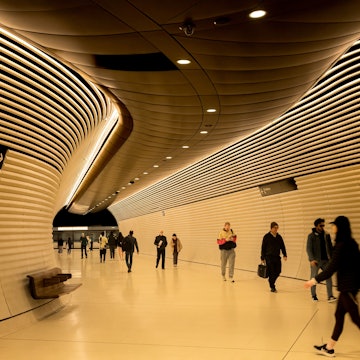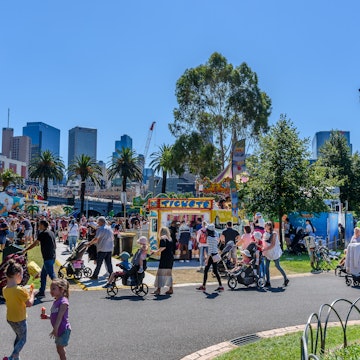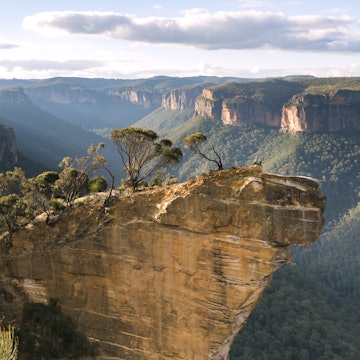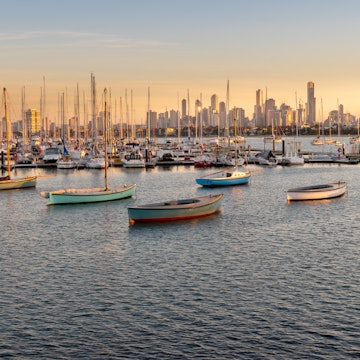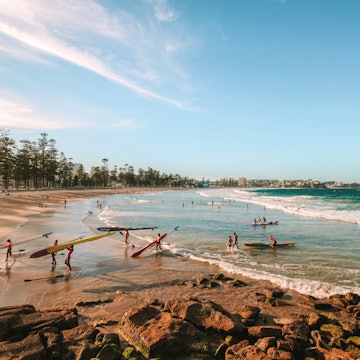
9 of the best places to see ancient Aboriginal rock art in Australia

Aug 26, 2025 • 9 min read
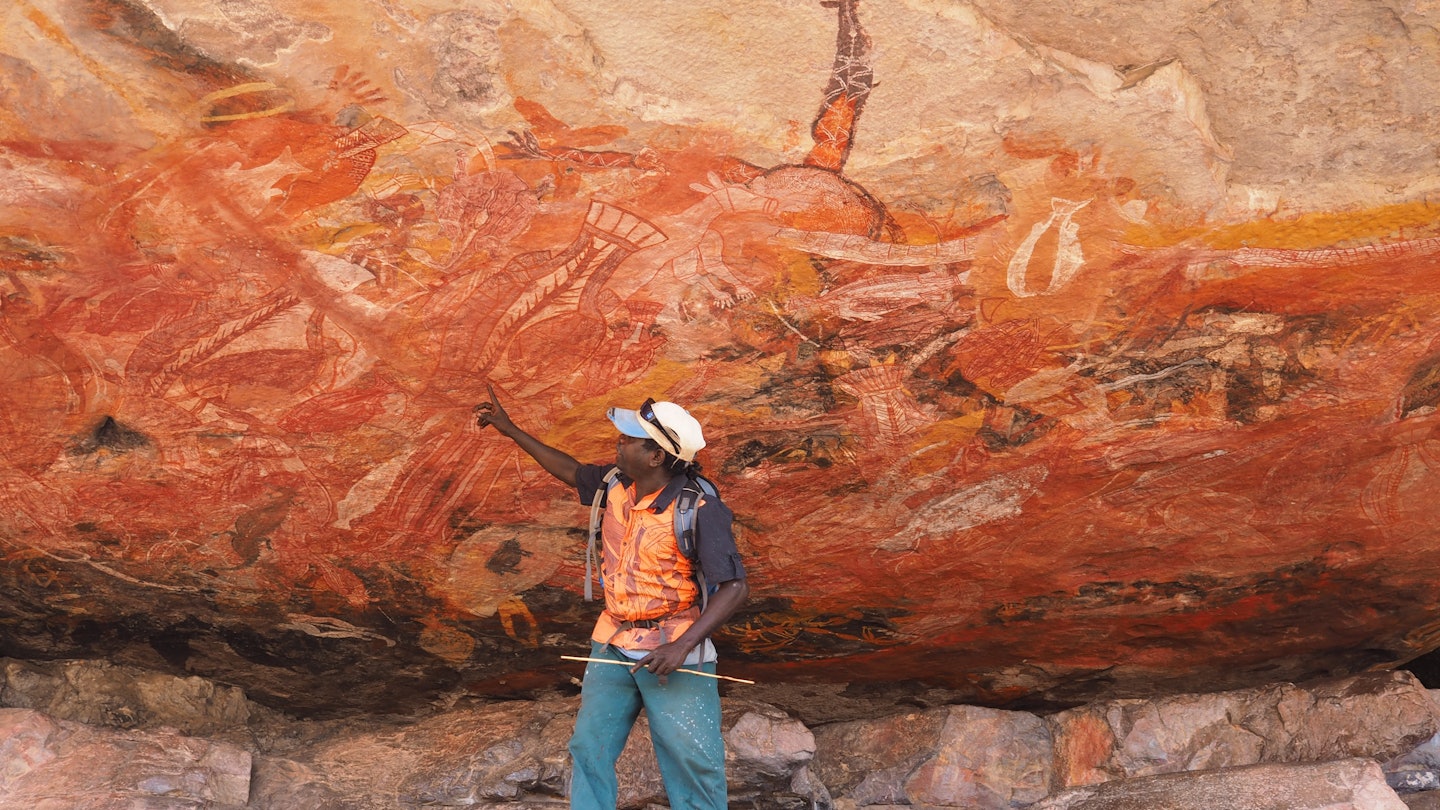
A guided tour at Injalak Hill in Arnhem Land, the Northern Territory. Sarah Reid
Did you know Australia is home to more than 100,000 significant Aboriginal rock art sites? Among them are the world’s oldest known petroglyphs and some of the oldest rock paintings, many of them created before the last ice age. These alfresco petroglyphs and paintings, typically created with ocher (a natural earth pigment), aren’t just decorative. They are powerful expressions of culture, spirituality and identity that reveal intriguing insights into the past, from the historical ranges of extinct wildlife to how humans adapted to rising sea levels over time.
While only a fraction of the nation’s rock art sites have been documented, there are plenty you can visit, and many of them are surprisingly accessible, including Australia’s newest World Heritage Site.

1. Murujuga, Western Australia
Best for petroglyphs
Inscribed by UNESCO in 2025, the Murujuga Cultural Landscape features over a million petroglyphs etched into the red-rock mounds of the Burrup Peninsula and Dampier Archipelago in Western Australia’s coastal Pilbara region. Featuring images of people, animals, ancestral beings and scenes from daily life, many of the petroglyphs are found in Murujuga National Park on Ngarda-Ngarli traditional lands.
The best place to view the engravings is at Nganjarli (formerly Deep Gorge), 25km (15.5 miles) north of Karratha. Here a 700m (767yd) wheelchair-accessible boardwalk with interpretive signage and viewing platforms follows the edges of natural rock piles full of petroglyphs, some of them over 47,000 years old. Notice the images of marine animals carved over the top of images of land animals. These artworks serve as a record of how local Aboriginal people adapted when sea levels rose about 8000 years ago, transforming the region from an arid interior plain into an archipelago.
For deeper insights, join Murujuga Aboriginal Corporation rangers for a rock art and cultural experience at Nganjarli. A virtual tour was also being developed by Ngarluma/Yindjibarndi man Clinton Walker at the time of publication; check the Ngurrangga Tours website for updates.
Planning tip: The best time for viewing petroglyphs at Ngajarli is late afternoon when the shadows make the engravings stand out. Find more petroglyphs on the Yaburrara Heritage Trail winding up behind Karratha.

2. Kakadu, Northern Territory
Best for accessible galleries
More than 5000 rock art sites have been documented in World Heritage-listed Kakadu National Park on the traditional lands of the Bininj/Mungguy peoples in the Northern Territory, with some works up to 20,000 years old.
The huge galleries of Ubirr, 288km (179 miles) east of Darwin/Garramilla, are linked by a 1km (0.6-mile) wheelchair-accessible loop trail. The main gallery is awash with paintings of the abundant foods available in the area including fish, wallabies and goanna painted in “X-ray” (a technique where the skeletal structure and internal organs are depicted alongside the outer form), which became the dominant style about 8000 years ago. Note the thylacine (Tasmanian tiger), believed to have become extinct on the mainland around 3000 years ago. The trail continues past the Rainbow Serpent gallery featuring a depiction of the powerful Creation ancestor known as Garranga'rreli, with a side trail leading up to the Nadab Lookout for sublime views across the floodplain.
Burrungkuy (Nourlangie)’s wheelchair-accessible Anbangbang Gallery, 70km (43 miles) south of Ubirr, is known for its vivid depictions of Creation ancestors Namondjok and Namarrkon, the Lightning Man. On the northern side of Burrungkuy (Nourlangie) is the Nanguluwurr Gallery. Reached via a 1.7km (1-mile) bush track, it features depictions of ancestral spirits and animals painted over thousands of years, as well as the early contact between Aboriginal people and the outside world (known as contact art) in the form of a two-masted sailing ship.
Planning tip: Ranger-guided walks are available at Ubirr and Burrungkuy (Nourlangie) during northern Australia’s dry season (May to October).
3. Sydney, New South Wales
Best for urban rock art
You don’t need to venture to the outback to see Aboriginal rock art, with several sites located just steps from Sydney/Warrane’s world-famous Bondi Beach on the traditional lands of the Bidiagal, Birrabirragal and Gadigal peoples. Carved into a flat sea cliff in North Bondi’s publicly accessible golf course are more than 60 engravings of fish and other marine creatures, humans, weapons and part of a kangaroo. Controversially regrooved in the 1960s, the engravings are easily visible.
With over 800 Aboriginal sites recorded across Ku-ring-gai Chase National Park in Sydney’s north, this is another great place to admire urban rock art. Featuring engravings of animals and human figures, the Basin Aboriginal Art Site is among the best examples.
Planning tip: Bus 333 from Circular Quay to North Bondi terminates close to Bondi’s rock art site. The Basin Aboriginal Art Site is 40km (25 miles) or an hour’s drive north of the city center – park at the trailhead of the Basin Track on West Head Rd; the rock art site is 400m (437yd) along the trail.
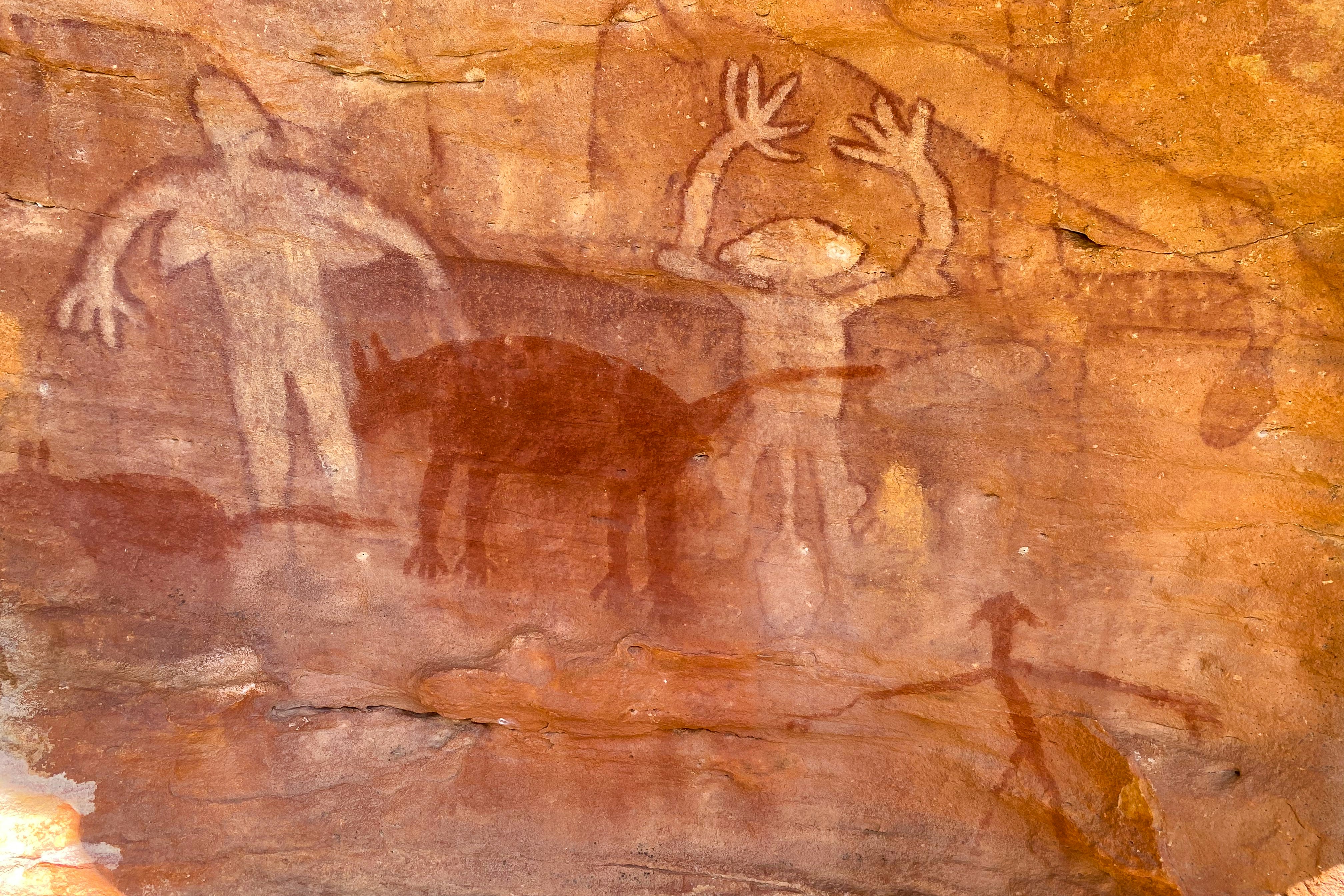
4. Quinkan Country, Queensland
Best for spirit figures
Covering about 23,000 hectares of the Laura Basin on northern Queensland’s Cape York Peninsula, Quinkan Country takes its name from the paintings of Quinkan spirit beings – tall slender Timaras and fat-bodied Imjims (or Anurra) – found all over the sandstone escarpments of this rugged savannah landscape. Painted by Western Yalanji, Kuku Warra, Possum and (Balnggarrwarra) Guugu Yimidhirr people, some works are thought to be up to 25,000 years old.
Tucked off the Peninsula Development Rd, 12km (7.5 miles) south of Laura, the Split Rock site is the easiest to visit. Featuring ocher paintings of humans, fish and other creatures, stencils of handprints, Quinkan (giant figures that represent spirits) and more, the first of its three main galleries is the largest. The highlight of the second gallery is the paintings of roosting flying foxes, while the third gallery features a painting of a Timara, who are believed to protect children from the malevolent Imjim.
To marvel at the region’s aptly named Magnificent Gallery, you’ll need to book an Aboriginal guided experience with Jarramali Rock Art Tours.
Planning tip: Quinkan Country is best visited during the northern dry season (May to October). The Split Rock site is 127km (79 miles) northwest from Cooktown via sealed roads.

5. Arnhem Land, Northern Territory
Best for X-ray art
Home to just 16,000 people in an area the size of South Korea, Arnhem Land is the Northern Territory’s wild northern frontier. More than 20,000 rock art sites have been recorded in the region, some 290km (180 miles) east of Darwin/Garramilla, and, like Kakadu, one of its most spectacular sites is also relatively easy to access.
A 30-minute drive from Ubirr in Kakadu, Injalak Hill is a red-rock cathedral rising from the traditional lands of the Bininj peoples. Here numerous rock shelters are slathered in layers of ocher artworks featuring the region’s distinctive X-ray style. Prepare to be astounded by the hatching detail in the paintings of barramundi, crocodiles, kangaroos and other animals, people and spirit figures.
The only way to visit is with a local Aboriginal guide, with up to three daily tours departing from the Injalak Arts Centre in nearby Gunbalanya. Guides share stories of how ancestors created the landscape and its inhabitants as you explore this elemental place – ask about the painting of Creation mother Yingarna pictured carrying her dilly (woven) bags.
Planning tip: The northern dry season (May to October) is the best time to visit. If you’re self-driving, you’ll need a permit from the Northern Land Council, or book a tour from Jabiru with Kakadu Tours & Travel.
6. Kimberley, Western Australia
Best for Wandjina and Gwion Gwion art
Western Australia’s northern frontier is also home to a rich collection of rock art. The region’s two main art styles are Wandjina art depicting Wandjina spirits held sacred by the Wunambal, Ngarinyin and Worrorra peoples; and Gwion Gwion art (also known as Bradshaw figures) featuring human figures ornamented with accessories.
Some of the best sites are located on islands and remote peninsulas only accessible by boat, such as Biggie Island, Jar Island and Raft Point. There’s more rock at Eagle Falls, reached by heli-tour. More accessible Wandjana and Gwion Gwion art sites are found just a few kilometers off the Kimberley’s famous Gibb River Rd at Munuruu (King Edward River), which has a campground.
Planning tip: The Kimberley is best visited in the northern dry season, and you’ll need a 4WD to tackle the Gibb River Rd. You can visit the Munuruu rock art sites independently, with Uunguu ranger-led tours offering an opportunity to connect with the culture embedded in the art and the surrounding landscape.
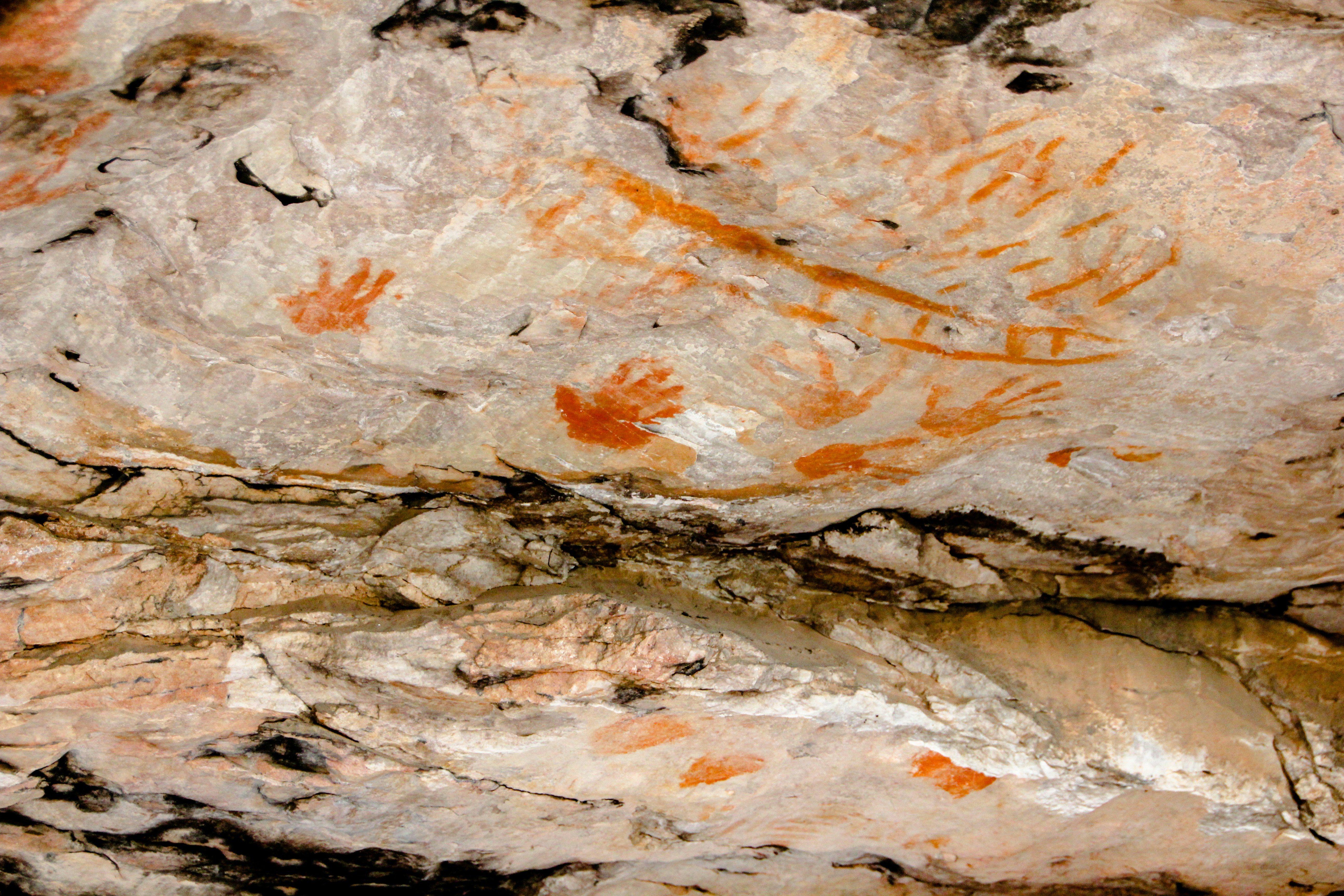
7. Grampians, Victoria
Best for a weekend road trip
The richest known repository of Aboriginal rock art in southern Australia is found in the Grampians/Gariwerd, 260km (162 miles) northwest from Melbourne/Narrm. There are approximately 200 rock art sites recorded in Grampians (Gariwerd) National Park, and you can visit all five sites open to the public in a two-day road trip from Victoria’s capital.
Make your first stop at Bunjil's Shelter in the Black Range Scenic Reserve near Stawell. Here you can see a depiction of the ancestral spirit Bunjil, Creator of the lands occupied by the Djab Wurrung and Jardwadjali peoples for more than 20,000 years, and his two dingoes. Then head to the northern end of Grampians National Park to visit the Gulgurn Manja shelter featuring handprints and emu tracks, and the Ngamadjidj Shelter for its white-painted figures. Continue south to Billimina Shelter, decorated with 2500 motifs including 55 human stick figures and hundreds of vertical lines thought to have been used to count events in retelling stories or to record the number of days spent at a place. Nearby is the Manja Shelter featuring some of Victoria’s best examples of hand stencils.
Planning tip: All five sites are accessed via short walking trails, with camping options including the Stapylton campground near the Ngamadjidj Shelter and the Buandik campground near the Billimina Shelter. Learn more about the local Aboriginal peoples and their art at the Brambuk Cultural Centre in Halls Gap on the eastern side of Grampians National Park.

8. Ikara-Flinders Ranges, South Australia
Best for a mix of ancient art
South Australia’s most notable rock art is found in the rugged landscape of Ikara-Flinders Ranges National Park, 450km (280 miles) north from Adelaide/Tarntanya. Follow the 3km (1.9-mile) circuit trail to Arkaroo Rock/Adnya, where ocher and charcoal images painted over 6000 years ago depict the Yura Muda (Dreaming or Creation story) of Wilpena Pound/Ikara, the park’s 800-million-year-old natural amphitheater. Or learn the stories behind the rock engravings at Sacred Canyon (Yura Malka), 20km (12.4 miles) southeast of Wilpena Pound/Ikara, on an Adnyamathanha guided cultural tour. These etchings are thought to have been made during the late final Pleistocene, at least 12,000 years ago.
Planning tip: Perched on the cliffs of Wilpena Pound/Ikara, Discovery Resorts – Wilpena Pound is the only accommodation within the national park. Just outside the park, the historic Arkaba Homestead offers a luxurious alternative located on a private wildlife conservancy.
9. Stanley Island, Queensland
Best for contact art
If you thought the two-masted sailing ship at Kakadu’s Nanguluwurr Gallery was impressive, wait until you see the rock art gallery on Stanley Island/Yindayin in northern Queensland’s remote Flinders Group National Park. A 2.8km (1.7-mile) return trail from Mangrove Landing in Owen Channel takes you to the Endaen rock shelter featuring over 100 paintings by Yiithuwarra artists using red, white and yellow ocher, including over a dozen depictions of various historic sailing boats that visited Australia, such as European luggers and Macassan (Indonesian) prau. It’s thought the paintings of European vessels could be 16th- or 17th-century Portuguese ships, making these paintings over 500 years old.
Planning tip: Unless you’re sailing on a private vessel (the Flinders Group is a popular anchorage for yachties), Stanley Island can only be visited on expedition cruise itineraries with the likes of Cairns/Gimuy-based Coral Expeditions.
The writer visited Murujuga with support from Tourism Western Australia. Lonely Planet does not accept freebies in return for positive coverage.






